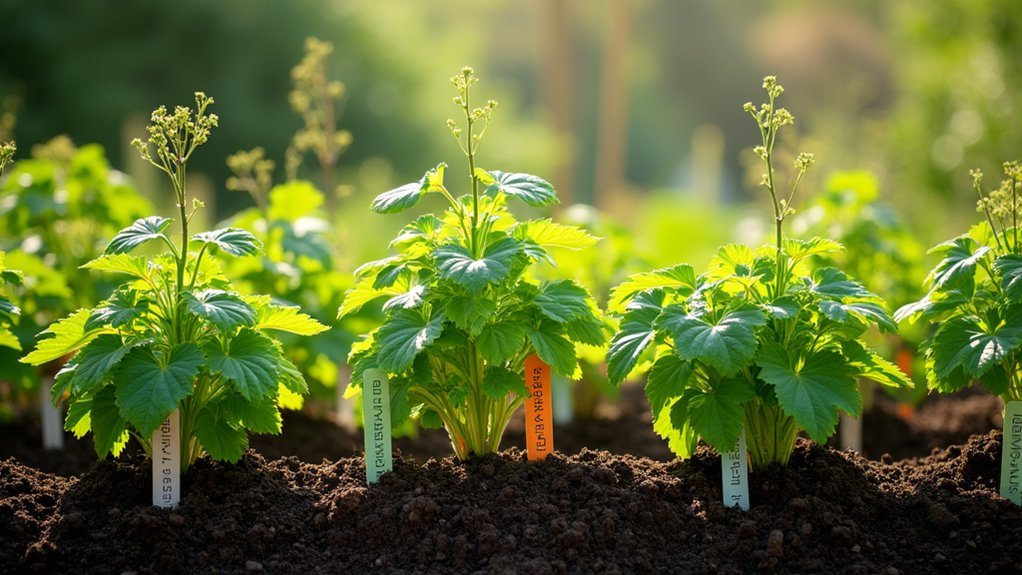To plant your edible hedgerow, first select compatible plants like hazelnuts, blackberries, and herbs that suit your climate and soil conditions. Next, prepare your soil by removing weeds, incorporating compost, and sheet mulching with cardboard for weed suppression. Finally, plant during the dormant season in a staggered pattern, water thoroughly, and apply mulch to retain moisture. With proper planning and post-planting care, your living food fence will provide years of delicious harvests.
Selecting the Right Edible Plants for Your Hedgerow

When planning an edible hedgerow, selecting the right combination of plants forms the foundation of your success. Consider including fruiting species like blackberries and crab apples for jams and jellies, or sea buckthorn for its vibrant orange berries.
For nuts, hazelnuts work excellently as main hedge components planted at standard spacings. Add aromatic herbs such as rosemary, thyme, and sage to enhance both culinary options and sensory appeal.
Structure your hedgerow with varying heights and densities, combining shrubs and small trees to create biodiversity layers. Most edible hedgerow plants benefit from being spaced 33cm apart for optimal growth. Always check hardiness ratings and climate adaptability – verify your selections match your local growing conditions.
For example, blackberries thrive in USDA zones 5a-8b, while crab apples (RHS H6) offer excellent cold tolerance and disease resistance.
Preparing the Soil and Planning Your Layout
Successful plant selection paves the way for the next important step: preparing your site and designing an efficient layout. Before planting, assess your soil’s pH and nutrient levels to confirm they’ll support your chosen edibles. Remove existing weeds and debris that could compete with your new plants.
The foundation of a thriving garden begins with thoughtful plant choices, followed by strategic site preparation and smart design.
Prepare your site with these key steps:
- Apply sheet mulching with overlapping cardboard to suppress unwanted vegetation
- Incorporate quality compost or well-rotted manure to boost soil fertility
- Aerate compacted soil using a digging fork for better root development
- Plan appropriate spacing between plants for good air circulation
- Consider a layered layout with various species for biodiversity and visual appeal
Allow your prepared bed to rest for a couple weeks before planting, then finish with a layer of straw mulch to retain moisture. When planning your hedgerow dimensions, aim for approximately 10 feet wide by 30 feet long to provide enough space for species diversity and productive growth.
Planting Techniques and Essential Post-Planting Care

Proper planting techniques and diligent aftercare form the foundation of a thriving edible hedgerow.
Choose your planting pattern based on desired density—staggered double rows with 40cm between rows create denser hedges using 5 plants per meter, while single rows work well at 3 plants per meter (33cm spacing) for species like wild pear.
Plant during the dormant season, soaking bare-root stock before planting to prevent shock.
Apply mulch immediately to retain moisture and suppress weeds.
Water weekly during the first two years, especially during dry periods.
Top-dress with compost annually in spring to maintain fertility.
Clear all weeds thoroughly and prepare a meter-wide strip for planting to ensure your edible hedge has adequate space to establish its root system.
Frequently Asked Questions
How Do I Protect Young Hedgerow Plants From Wildlife Damage?
To protect young hedgerow plants from wildlife damage, you’ll need hardware cloth barriers, dead hedging, cleared perimeters, heavy mulching, and regular monitoring. Don’t forget supplemental irrigation to strengthen plants against browsing pressure.
Can I Incorporate Medicinal Plants Into My Edible Hedgerow?
Yes, you can definitely incorporate medicinal plants into your edible hedgerow. They’ll provide ecological benefits, attract beneficial insects, and offer healing properties while requiring less maintenance than many food crops.
How Do I Create Microclimates Within My Hedgerow Design?
You’ll create microclimates by varying plant heights, density, and orientation. Layer trees, shrubs, and herbs strategically. Use taller plants as windbreaks and consider sun exposure patterns when placing species throughout your hedgerow design.
When Is the Best Time to Harvest Various Hedgerow Products?
You’ll harvest fresh greens in April, elderberries from July to October, and beech nuts from mid-September. Don’t forget to cook elderberries before eating, and you can freeze sloes overnight to mimic frost bletting.
How Can I Propagate New Plants From My Established Hedgerow?
You can take cuttings from established plants, divide clumps, use layering techniques, collect runners, or gather seeds. Time your propagation based on plant cycles and use sharp tools for best results.
In Summary
With your edible hedgerow planted, you’ll soon enjoy fresh berries, nuts, and herbs right from your property boundary. Remember to water regularly during the first year, prune annually, and harvest at peak ripeness. You’ve created not just a beautiful living fence but a sustainable food source that benefits wildlife too. Enjoy watching your edible landscape mature and thrive for years to come.





Leave a Reply